

IN MEMORy by Pierre Vandervelden
The visit to Commonwealth graves in Communal Cemeteries & Churchyards in Belgium & France
CHAMPIGNOL lez MONDEVILLE Churchyard (Aube France)
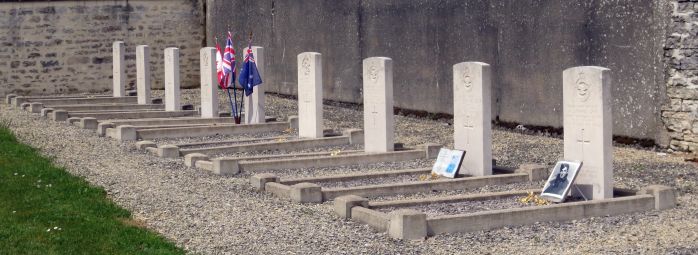 |
| L. to R.: P. L. Johnson - M. Hopkins - W. A. H. Ball - J. H. Lovell - C. W. W. Peck - R. P. Strain - W. J. Rose - A. V. R. S. Wilson - A. J. Perrin |
| Photo Courtesy Isabelle, Guillaume van der Wende & Jean-Claude Graux (Fr) |
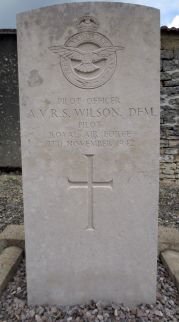 |
 |
| P/O A. V. Ronald Sydney Wilson DFM 07/11/1942 | |
 |
 |
| Sgt John "Jack" Henry Lovell
DFM 17/05/1917 - 07/11/1942 Son of Earnest Carrington Lovell and Ellen Linda Lovell, in Stanley, Tasmania, Australia. He enlisted on 03/01/1941 in Hobart. for his nephew Graeme Lovell |
|
The
crew of the Avro Lancaster L7546 EM-G was awarded the D. F. M. |
|
| 778285 Flight Sergeant William James
ROSE, No. 207 Squadron. 1271000 Sergeant Ronald Sydney WILSON, No. 207 Squadron. Aus.408145 Sergeant John Henry LOVELL, Royal Australian Air Force, No. 207 Squadron. 1258979 Sergeant Arthur John PERRIN, No. 207 Squadron. Can./R.100368 Flight Sergeant Charles Woodrow Wilson PECK, Royal Canadian Air Force, No. 207 Squadron. As navigator, pilot, wireless operator/air gunner and rear gunner respectively, these airmen flew in an aircraft which took part in an attack on Le Creusot on 17th October, 1942. Shortly after taking off, engine trouble developed. Despite great efforts, Sergeant Wilson was unable to continue his mission and course was set for base. Near to the French coast, whilst flying at only 40 feet above the sea, the aircraft was attacked by three enemy float planes. In the face of a trying situation Sergeant Wilson displayed fine airmanship and, splendidly supported by his gunners whose skill destroyed two of them and drove off the third, he eventually flew the aircraft back to an aerodrome in this country. During the combat Flight Sergeant Rose coolly continued his duties and his subsequent navigation was of the greatest assistance to his pilot. Throughout, this crew displayed great courage, high skill and perfect teamwork. Extract from the London Gazette 20/11/1942 P5033 http://www.london-gazette.co.uk/issues/35791/supplements/5033/page.pdf The aircrew was awarded the DFM. (Jack was the wireless operator/air gunner in the crew so he actively contributed to the destruction of two of the attacking three aircraft.) |
|
More
about Jack's D. F. M. |
|
| Peck, FS Charles Woodrow Wilson (R100368)
- Distinguished Flying Medal - No.207 Squadron - Award effective 6 November
1942 as per London Gazette dated 20 November 1942 and AFRO 1962/42 dated
4 December 1942. Born at Fort William, Ontario, 4 July 1917; home in Port
Arthur (grain sampler); had 30 days Militia training; enlisted Winnipeg
9 April 1941. To No.2 Manning Depot, 19 April 1941; to No.33 SFTS (guard
duty), 3 May 1941; to No.2 ITS, 8 June 1941; graduated 204th in a class
of 235 (“This airman is a hard worker, dependable and not afraid of
responsibility”) and promoted LAC, 14 July 1941 when posted to No.5
EFTS where he logged two hours 35 minutes dual and five hours five minutes
solo; ceased training on 26 August 1941 and posted to Trenton, 8 September
1941;to No.4 BGS, 27 September 1941; graduated and promoted Sergeant, 24
October 1941. To “Y” Depot, 25 July 1941; to RAF overseas, 11
November 1941. Taken on strength of No.3 PRC, 23 November 1941. To No.7
Air Gunner School, 7 February 1942; to No.25 OTU, 17 March 1942. Promoted
Flight Sergeant, 22 May 1942. To No.44 Squadron, 7 July 1942. To No.207
Squadron, 4 September 1942. Killed in action with No.207 Squadron, 7 November
1942; buried in France. As rear gunner this airman flew in an aircraft which took part in an attack on Le Creusot on the 17th October, 1942. Despite great efforts the pilot was unable to continue his mission and the course was set for base. Near the French coast, whilst flying at only forty feet above the sea, the aircraft was attacked by three enemy planes. In the face of a trying situation, the pilot displayed fine airmanship and, splendidly supported by his gunners whose skill destroyed two of them and drove off the third, he eventually flew the aircraft back to an aerodrome in this country. During the combat the navigator cooly continued his duties and his subsequent navigation was of the greatest assistance to his pilot. Throughout, this crew displayed great courage, high skill and perfect team work. Public Record Office Air 50/232 has combat report for Lancaster L7580, A/207, 17 October 1942 (note: citations for other awards identify aircraft as L7583). Crew were identified as Sergeant Ronald Sydney Wilson (pilot, awarded DFM), Sergeant William James Rose (navigator, later awarded DFM), Sergeant John Henry Lovell (RAAF, air bomber, later awarded DFM for this action), Sergeant Chalmers (flight engineer), Sergeant Arthur John Perrin (WOP, awarded DFM), Flight Sergeant Peck (rear gunner) and Sergeant Weeks (mid-upper gunner). Takeoff time given as 1154 hours, landing time as 1853 hours. In good weather conditions, approximately 8/10 cloud with base at 1,000 feet, visibility below cloud being excellent, three Arado 196 float planes were encountered at an approximate position 48? 10\' North 05? 30\' West. The bomber flying at 150 A.S. at a height of 40 feet on a course 315? Magnetic at 1700 hours sighted two of the enemy aircraft flying abreast just above sea level and a third enemy aircraft about one mile astern at the same height. The first enemy aircraft attacked from astern opening fire at approximately 300 yards. The rear gunner of the bomber got in four short bursts and the enemy aircraft turned over on its back and crashed into the sea with black smoke pouring from the engine. The second aircraft attacked from the port beam. The bomber turned into it when the mid-upper and front gunner got in two short bursts. No results were observed. The third enemy aircraft commenced attack from port, around rear of bomber to starboard and made beam attack. Front gunner got in a long burst when enemy aircraft turned over and crashed into the sea. Before it crashed, however, a bullet entered the bomber, killing the flight engineer. The second enemy aircraft again attacked from port quarter. Rear gunner got in a burst and mid-upper gunner two burst but no results were observed. The enemy aircraft then sheered off in the direction of the French coast. The Arado float planes appeared to carry one gun either side of the engine, one through the propeller, whilst a rear gun was manned by the second member of the crew. Both cannon shells and rifle base bullets were used but it was not ascertained as to which gun in the front of the machine was the cannon. Evasive action taken was turning into the attack and corkscrewing. Note on training: Interviewed by F/O W.P. Grahan, 7 April 1941, who wrote, “Good average intelligent type of young man. Anxious to serve. Should make a fair pilot.” When he failed at EFTS, F/L R.F. Gladden (CFI) wrote, “Below average ability on ground subjects. Low average ability in flying. First progress test on ground subjects, 10 percent; second, 50 percent. Conduct has only been fair. Does not appear to be very bright.” As Air Gunner, No.4 BGS, course lasted 29 September to 24 October 1941. Flew 11 hours 45 minutes in Battle (plus two hours five minutes as passenger.” Gunnery results were 3.83 percent in Beam Test, 3.43 percent in Beam Relative Speed Test, 5.17 percent in Under Tail Test. Fired 425 rounds on ground, 200 rounds air to ground and 1,875 rounds air-to-air. Marked 71 percent on written exam, 68 percent on oral exam and graded 171/150 on “Ability as Firer.” Placed 21st in a class of 23. “Only fair as an Air Gunner. His flying experience at EFTS should help him.” The website “Lost Bombers” has the following on his loss. Lancaster L7546 of No.207 Squadron (EM-G), target Genoa, 7/8 November 1942. Delivered to No.44 Squadron on 17 January 1942 for Avro wing tests, joining No.207 Squadron on 2 November 1942. It took part in the following operations: with No.44 Squadron as KM-J, Gardening Yams, 3 March 1942 (first aircraft off on first Lancaster operation); with 207 Squadron as EM-G, Genoa 7/8 November 1942 when lost. Airborne at 1801 hours, 7 November 1942 from Langar. Crashed at Champignol-lez- Mondeville (Aube), 11 km SW of Bar-sur-Aube, France. Crew (all killed) were P/O A.V.R.S.Wilson, DFM; Sergeant W.A.H.Ball; Flight Sergeant W.J.Rose, DFM; Sergeant J.H.Lovell, DFM; Flight Sergeant A.J.Perrin, DFM; Flight Sergeant R.P.Strain, RCAF; Flight Sergeant C.W.W.Peck, DFM, RCAF. Spource: This is reported for Canadian crew member CWW Peck : http://airforce.ca/awards.php?keyword&page=588&type=rcaf |
|
Translated
letter from Raymond Dore which gives a witness account of the crash |
|
| Mademoiselle, Monsieur, the Curate of Champignol has brought me your letter of 19th August 1945 in order to translate it and at the same time has charged me to reply to you because I am one of those who assisted at the accident which happened. I must ask you to excuse me writing in French although I speak and read English fairly easily, I am not capable of explaining just what happened in your language. First of all, I will tell you who I am. My name is Raymond Doré. I used to live in Paris before the war, but in 1940 with many others I was made a prisoner, then taken to Germany from where I escaped in 1941. I then came to Champignol as a refugee, and I am still here provisionally. Early in November at 8 p.m. I happened to be outside and I heard the English bombers which were carrying bombs to Italy. This was a great joy to me, when suddenly I saw a flash in the air, then some seconds later another and the Lancaster fell into flames with a formidable noise. Either it had collided with another bomber or had been shot down by a night fighter. Immediately everyone ran out, but we could not get near. It was only the next day, although the Germans were there, that we were able to approach. The same day I found in the neighbourhood a parachute carrying the name of Sergeant Lovell. I succeeded in bringing it home and hiding it, but some time after, the Germans having arrived, I was obliged to destroy it. Nevertheless, I have saved some few pieces, which I will send to you if you wish. A month after the accident, a cousin of mine found in the wood in the neighbourhood of the crash the body of Mr. Peck and still another month later, exactly, the bodies of Mr. Ball and Mr. Lovell, at about 10 yards from each other. I believe it was the explosion that had thrown them there, they neither of them had a parachute. They were found by 2 young men — one was killed by the Germans last year, because he belonged to the marquis — the other is still here. Immediately I went to see the two bodies, which were well preserved by the snow and frosts; they were quite unmarked — Sergeant Lovell was dressed in a khaki suit with a fur collar and shiny fasteners on legs and arms. When the Germans had inspected, I managed to see his papers which had on them Sergeant John H. Lovell. He was a young boy, small and fair, his identity is certain. He and his comrade were placed in coffins and buried in the parish cemetery. The Germans were there and had forbidden the inhabitants to come to the cemetery, but as soon as they had gone, everybody was there. There is often, almost every week, a religious service on their behalf; their tombs are covered in flowers. The Germans have even made threats about this. I have seen the graves with so many flowers that women who have come with bunches have found no space for them. Believe me, dear Miss, that your dead are our dead, they have fought for the same ideal; and we French, shall not forget it. I cannot tell you the great gratitude I feel each time I pass your flyers. We know well that it was for our liberation. Your seven aviators are not alone in the cemetery. In May 1944, 2 more were killed, but one succeeded in escaping. He has been harboured in a farm, and has now joined our marquis. There are then 9 gallant men, our allies, near our soldiers at the bottom of the cemetery. We shall always be very happy for you to visit here. Could you bring with you the parents? I shall perhaps not be here and that I shall regret, but everybody will show you all things. Excuse me telling you all this truth; it is so terrible; but I wish you to know all. I end, Mademoiselle, begging you to accept from me and all the population our sincere and grateful sympathy and greetings. (sgd.) Raymond Doré |
|
Jack
and his brothers |
|
 |
|
| Jack, left, with his two brothers,
Arthur Carrington, middle and William "Bill" Thomas, right. Fl/Lt Arthur Carrington Lovell S/N256985 17/09/1913 1994. Arthur was a pioneer of Australian aviation and is shown in his ANA pilot’s uniform. He lived in Melbourne and was based at Essendon airport. He was seconded to the RAAF during the war and flew missions evacuating civilians from Papua New Guinea as well as other missions. His civilian aircraft (most likely DC2s) were defenceless and his only escape from the Japanese fighters was to fly into a cloud and fly in circles until the Japanese flew away. Arthur was given a Letter of Commendation by American General George C. Kenney who was in charge of air operations in PNG. This letter recognised Arthur’s substantial contribution to the war effort in PNG. Arthur had a distinguished career in civil aviation and was chief pilot at ANA and later at Ansett. He flew the first jet airliner (a Boeing 727) to Australia, arriving from Fiji with Reg Ansett aboard. There are references to Arthur in Peter Yule’s book “The Forgotten Giant of Australian Aviation” and Nancy Witcomb’s book “Up Here and Down There”. Fl/Lt William "Bill" Thomas Lovell S/N 408044 08/02/1916 - 29/10/2005 He enlisted in Hobart on 15/08/1940 Bill is shown in Observer uniform in the photo. He trained in Ballarat. In England Bill flew in 455 Squadron flying Hampden bombers. On 02/09/1942 this squadron flew to Murmansk in Russia with high losses. Their mission was to bomb the Tirpitz in the fjords of Russia, this was unsuccessful. After 6 weeks the airmen were evacuated by ship leaving the aircraft in Russia. This mission was documented extensively in Geoffrey Raebel’s book “The RAAF in Russia”. Bill had the nickname “Snowy”. They were dressed in normal flying uniforms and totally unprepared for Russian conditions. Bill had problems with tissue damage from frostbite in later life, requiring ongoing medical attention to his feet. He was given a Russian Star for his service to Russia before leaving Murmansk. On return to England Bill was at a social function and went to collect his coat to find that his rare Russian Star had been removed from his coat. On reporting this, the social function was locked down with no-one allowed to leave until the star was returned with no questions asked. Fifty years after the war the Russian government tracked him down and presented him with a commemorative medal in recognition of his service in Russia. After the war Bill “flew a desk” with Qantas including postings to Djakarta, Tokyo and Wellington. |
|
| Information compiled by their nephew Graeme Lovell | |
 |
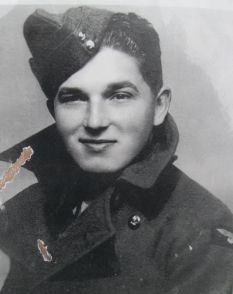 |
| Fl/Sgt Arthur John Perrin DFM 07/11/1942 aged 21 | |
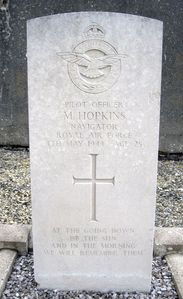 |
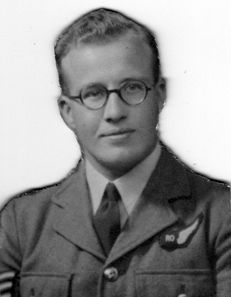 |
 |
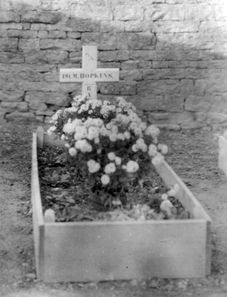 |
| P/O Mervyn Hopkins 04/05/1944 aged
25 He enlisted in 1941 with the RAFVR and qualified as a Sergeant Radio Operator. He was commissioned as a Pilot Officer Navigator in 04/1944, one month before being killed in a Mosquito crash. for Robert Courtney (Aus.) |
|
9 casualties
BALL WILLIAM ALFRED HENRY
United Kingdom Sergeant (Flt. Engr.) Royal Air Force 207 Sqdn. Date of Death:
07/11/1942 Service No: 523218 (3)
HOPKINS MERVYN
United Kingdom Pilot Officer (Nav.) Royal Air Force Volunteer Reserve 169 Sqdn.
Age: 25 Date of Death: 04/05/1944 Service No: 171701 (2)
JOHNSON PETER LISTER
United Kingdom Pilot Officer (Pilot) Royal Air Force Volunteer Reserve 169 Sqdn.
Date of Death: 04/05/1944 Service No: 169067 (1)
LOVELL JOHN HENRY
Australian Sergeant Royal Australian Air Force Age: 25 Date of Death: 07/11/1942
Service No: 408145 (4)
PECK CHARLES WOODROW WILSON
Canadian Flight Sergeant (Air Gnr.) Royal Canadian Air Force 207 (R.A.F.) Sqdn.
Age: 25 Date of Death: 07/11/1942 Service No: R/100368 (5)
PERRIN ARTHUR JOHN
United Kingdom Flight Sergeant (W.Op./Air Gnr.) Royal Air Force Volunteer Reserve
207 Sqdn. Age: 21 Date of Death: 07/11/1942 Service No: 1258979 (9)
ROSE WILLIAM JAMES
United Kingdom Flight Sergeant (Nav.) Royal Air Force Volunteer Reserve 207
Sqdn. Age: 23 Date of Death: 07/11/1942 Service No: 778285 (7)
STRAIN ROBERT PETER
Canadian Flight Sergeant (W.Op./Air Gnr.) Royal Canadian Air Force 207 (R.A.F.)
Sqdn. Date of Death: 07/11/1942 Service No: R/92290 (6)
WILSON A V R S
United Kingdom Pilot Officer (Pilot) Royal Air Force Volunteer Reserve 207 Sqdn.
Date of Death: 07/11/1942 Service No: 135004 (8)
IF You have a casualty picture, please send me a copy, I'll be glad to show it on this page.
IF You want a king size copy of this picture (300/900 ko - 2592/1944 pixels) please e-mail me.
IF You want picture of a particular grave, in this cemetery, please e-mail me.
Casualties informations come usualy from Commonwealth War Graves Commission, see links for more informations
Inmemories.com © Pierre Vandervelden - Belgium